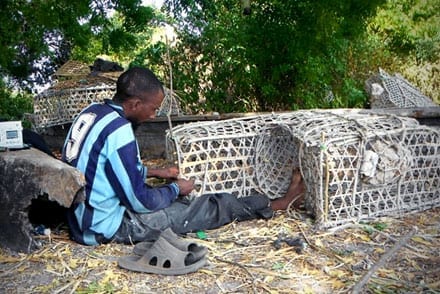
New basket traps designed by WCS and Kenyan Marine and Fisheries Research Institute allow juvenile and non-target fish species to escape while increasing incomes
Scientists from the Wildlife Conservation Society and the Kenyan Marine and Fisheries Research Institute have achieved a milestone in Africa: they’ve helped build a better fish trap, one that keeps valuable fish in while letting undersized juvenile fish and non-target species out.
By modifying conventional African basket traps with escape gaps, the marine researchers have proven that the new traps catch larger fish, allow more undersized and non-target fish to escape, increase profits, and—most importantly—minimize the impact of fishing on coastal reef systems. The findings, say researchers, will help fishing communities boost profits while protecting their vital marine resources.
A paper on the experimental study appears in the current edition of Fisheries Research. The authors include E.K. Mbaru of the Coral Reef Conservation Project and the Kenyan Marine and Fisheries Research Institute; and Tim McClanahan of the Wildlife Conservation Society.
“One of the great challenges in coastal fisheries is how to reduce the levels of bycatch for reef systems where these species play important ecological roles,” said Dr. Tim McClanahan, co-author of the study and head of WCS’s coral reef research and conservation program. “Our modified traps have made a statistically measurable difference in minimizing bycatch for African basket traps. Such innovations can make a big difference in maintaining the ecology of vital coastal resources.”
The experimental study was conducted in the fished reef systems near a marine park on the coast of Mombasa, Kenya. Importing the escape gap idea to African waters for the first time, the researchers worked with an experienced trap fisher who built six basket traps—iron-framed structures with netting and a single, tube-shaped opening leading into the middle of the trap. Half of the traps were constructed with escape gaps measuring 12 inches by an inch and a half. The escape gaps were designed to allow undersized and non-target fish to exit while retaining commercially valuable adult fish.
Once baited, the traps were deployed some 30 meters apart and between 5 and 10 meters in depth and checked once a day between October 2010 and October 2011. After 41 weeks, the researchers captured more than 1,200 fish from 64 species. The fish captured in the experimental traps were on average 31 percent longer and 55 percent heavier than fish in the regular traps without gaps (used for control data). By contrast, the regular traps had smaller fish, including the juvenile and ornamental fish important for maintaining reef ecology. The researchers also reported a 25 percent increase in economic value in the fish captured in the escape-gap traps, mostly valuable rabbitfishes.
The escape-gap traps also allowed smaller non-target fish to escape. Of the fish caught in the escape-gap traps, only 34 individual fish belonging to “bycatch” species (or 2 percent) remained in the traps, as opposed to 110 individuals (or 6 percent of the catch) from non-commercial species in the regular traps.
“These new escape gaps are a game changer for Kenya’s coastal fisheries,” said Dr. Caleb McClennen, Director for WCS’s Marine Programs. “By reducing bycatch, the new basket traps increase fish size, economic return, while limiting the bycatch that can harm entire reef systems. These innovations can also be exported to other coastal fisheries for the benefit of entire regions.”
The Latest Bing News on:
Better fish trap
- How to Fly Fish | A Guide To Small Water Fly Fishing Successon May 5, 2024 at 7:11 am
Match the hatch and conquer the cast. This guide reveals what you need to know about successful fly fishing in creeks and streams.
- A personal-use mackerel fishery is coming, but P.E.I. fishers don't know whenon May 4, 2024 at 3:00 am
Lobster fishers on P.E.I. say they're happy to hear that a personal-use mackerel fishery will open this year, but they're not sure it will help them with bait during the spring season. "If we got a ...
- Top 4 myths about wolves, busted by expertson May 3, 2024 at 11:33 am
The world’s largest canine draws both reverence and ire. Here are some of the most common misunderstandings, according to scientists.
- How a 'death trap' for fish in California's water system is limiting the pumping of supplieson May 2, 2024 at 7:35 am
As California pumps water south, an elaborate operation focuses on rescuing fish. Lately, more fish have been arriving, forcing the state to pump less water.
- Good for your health and the environment: Why we should be eating oily fishon April 23, 2024 at 6:00 am
Oily fish lends itself to a multitude of uses in the kitchen, from simple grilling or griddling to more elaborate dishes like tataki or papillote. One advantage of oily fish is that it is easy to ...
- The Best Cast Nets of 2024on April 22, 2024 at 8:04 am
you will be better served with a smaller one. As the net sinks, it captures fish inside. When the net hits bottom, the angler pulls the handline to close the bottom of the net and trap the fish.
- 350 dragon fish traps seized in Juneon April 3, 2024 at 5:00 pm
GEORGE TOWN: The Penang Fisheries Department has successfully seized 350 dragon fish traps (bubu naga) worth around RM35,000 in June alone in several operations to curb the use of the banned ...
- How To Build Every Trap In Sons Of The Foreston December 19, 2023 at 10:25 pm
Better than the Bird Box for gathering feathers ... However, as a whole, these types of traps are not worth the resources and time. Fish Traps only catch one fish at a time; Kelvin can be ordered ...
- Where the Salmon Ruleon September 7, 2023 at 11:33 am
Those traps were the end point for spawn-ready ... She considers that for a second or two, and answers carefully: "Better for fish." ...
- The fish trapon July 10, 2023 at 4:53 pm
Whale sharks are the largest fish in the sea, but they are filter-feeders eating mostly plankton and small fish and, according to received wisdom, rarely interact with humans. So when whale sharks ...
The Latest Google Headlines on:
Better fish trap
[google_news title=”” keyword=”Better fish trap” num_posts=”10″ blurb_length=”0″ show_thumb=”left”]
The Latest Bing News on:
Reducing bycatch
- Alaska lawmakers, residents ask feds to limit how much salmon industrial trawlers catchon April 30, 2024 at 6:14 pm
Plenty of fish in the sea? Not so according to Alaska lawmakers and residents who want the feds to limit industrial fishing before it's too late.
- Alaska lawmakers, residents ask feds to limit how much salmon industrial trawlers catchon April 29, 2024 at 11:48 pm
U.S. Rep. Mary Peltola, Alaskan Natives and family-owned fisheries are looking for a sea change in the fishing rights battle between local fishermen and industrial trawling fishing operations ...
- 'We should be at the table' say Alaskan indigenous tribes impacted by commercial fisherieson April 24, 2024 at 1:41 pm
“A lot of fishermen rightfully point out to me the significant reduction in bycatch among certain species in 2023 after my campaign lifted up this issue in the last election. We’ve ...
- 'We should be at the table' say Alaskan indigenous tribes impacted by commercial fisherieson April 24, 2024 at 12:42 pm
Fishing rights in Alaskan waters is a centuries-old tradition for local communities now impacted by commerical trawlers ...
The Latest Google Headlines on:
Reducing bycatch
[google_news title=”” keyword=”reducing bycatch” num_posts=”10″ blurb_length=”0″ show_thumb=”left”]










